How Do You Snorkel? A Beginner’s Guide
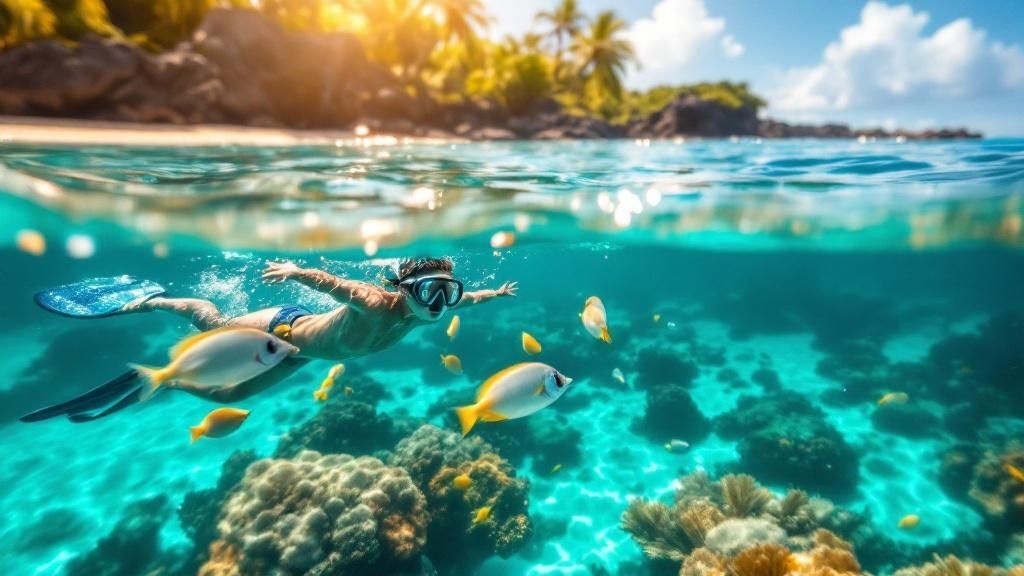
Picture this: you're floating effortlessly on the water's surface, completely weightless, while a vibrant, silent world unfolds right below you. That's snorkeling in a nutshell. It's the simple practice of using a mask for a clear view, a snorkel tube to breathe while your face is in the water, and fins to move around with ease. Its sheer accessibility is what makes it one of the absolute best ways to explore the ocean.
Your First Look Beneath the Waves
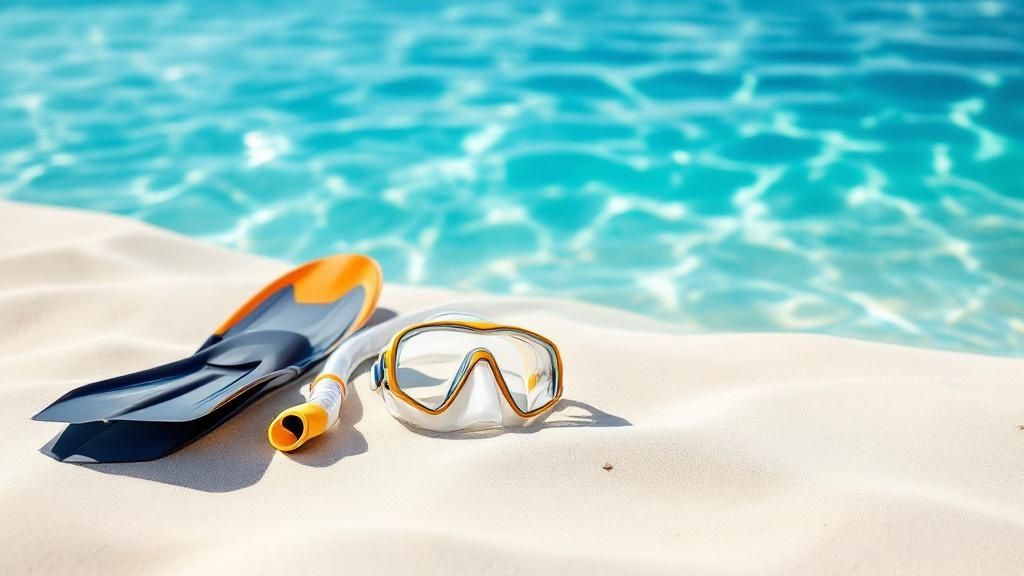
The real magic of snorkeling is how it opens up a whole new dimension with almost no barrier to entry. Unlike scuba diving, which demands certification and a lot of complex gear, snorkeling lets just about anyone become an instant underwater observer. I promise you, that feeling of putting your face in the water for the first time—seeing a bustling world of colorful fish and intricate coral—is something you'll never forget.
It's no surprise this activity has exploded in popularity, becoming a cornerstone of coastal tourism all over the globe. The global snorkeling equipment market was valued at a whopping USD 2.5 billion in 2024, which just goes to show how many people are discovering this incredible pastime.
What to Expect on Your First Adventure
Your first time in the water is a full-on sensory experience. You’ll hear the rhythmic sound of your own breathing through the snorkel, punctuated by the soft crackling of the reef below. The water feels incredibly supportive, and with fins on your feet, you'll feel like you're gliding almost effortlessly.
The real goal here is relaxation. Instead of actively swimming and thrashing about, you just float. Let the gentle currents do the work. This calm approach not only saves your energy but also makes you far less intimidating to the very marine life you came to see.
The biggest takeaway is to let the gear work for you. Trust your mask to keep your view crystal clear, your snorkel to deliver air, and your fins to push you along. Your only job is to relax, breathe, and take it all in.
From Intimidation to Excitement
It's completely normal for beginners to feel a little hesitant before their first time snorkeling. I see it all the time. People worry about breathing through a tube or what they might see in the water. But those concerns almost always melt away the second you're floating comfortably in calm, clear water. Starting in a protected bay is the perfect way to build up that confidence.
With just a handful of basic skills, that initial flicker of uncertainty transforms into pure excitement for what lies beneath the surface. It’s all about witnessing nature in its purest, most beautiful form.
And when you're ready to find that perfect spot, our guide on the top 15 best snorkeling spots on the Big Island is a great place to start.
Choosing Your Snorkeling Gear with Confidence
Your gear is your personal window to the underwater world, so getting the right equipment is the absolute first step toward a fantastic day. I’ve seen it countless times: a poor fit leads to a frustrating day of fiddling and adjusting, but the perfect gear makes you forget you're even wearing it. This isn't about spending a ton of money or chasing brand names; it’s all about what works for your body and comfort level.
It's no surprise that as more people discover the magic of the ocean, the equipment just keeps getting better. The global snorkeling gear market was valued at a whopping $3.6 billion in 2023 and is expected to keep climbing. You can read more about this growth on Dataintelo, but what it really means for you is that technology is making snorkeling safer and more enjoyable than ever.
To help you sort through the options, I've put together a quick comparison of the basic gear you'll need. Think of it as a starting point to help you ask the right questions when you're at the shop.
Snorkel Gear Comparison Guide
| Gear Type | Best For | Key Feature | Consideration |
|---|---|---|---|
| Classic J-Tube Snorkel | Budget-conscious snorkelers; those who don't mind learning to clear water. | Simple, reliable, and affordable. No moving parts to break. | Requires you to forcefully exhale ("blast clear") if water gets in. |
| Dry-Top Snorkel | Beginners, kids, or anyone nervous about swallowing water. | A valve on top seals completely when submerged, keeping all water out. | Can feel a bit bulkier and may require more maintenance on the valve. |
| Full-Foot Fins | Warm water snorkeling where you can enter from sand or a boat. | Worn barefoot, they are lightweight and easy to pack. | Offers no foot protection for walking over rocky or rough entries. |
| Open-Heel Fins | Colder water or entries over rocks, coral rubble, or uneven shorelines. | Worn with neoprene booties for warmth and protection. | Heavier and bulkier to travel with; requires a separate purchase of booties. |
This table just scratches the surface, but it gives you a solid idea of how different gear types serve different needs. The most important thing is to find what makes you feel comfortable and confident in the water.
Finding Your Perfect Mask
A leaky mask is the number one fun-killer on a snorkel trip. The most critical factor isn't the price; it’s the seal it creates against your face.
Here’s a simple trick I always tell people to do in the store. It will save you a world of trouble later.
- Without using the strap, hold the mask gently against your face.
- Now, inhale a little bit through your nose.
- Let go.
Does it stick? If the mask stays put just from that little bit of suction, you’ve found a good seal. If it falls right off, that mask just isn’t the right shape for your face. Move on and try another.
One of the biggest mistakes I see is people cranking the strap down super tight to stop a leak. The strap is just there to hold the mask in place; it's the gentle pressure from the water and a good silicone skirt that actually creates the seal.
Selecting the Right Snorkel Tube
Not all snorkels are just simple tubes anymore. They generally fall into a few different categories, and your choice really comes down to how comfortable you are in the water.
- Classic J-Tube: This is the old-school, no-frills design. It’s basically an open plastic tube. They are cheap and get the job done, but you’ll have to master the "blast clear" technique to blow out any water that splashes in.
- Semi-Dry Snorkel: A great middle-ground option. These have a splash guard on top that does a surprisingly good job of deflecting water from waves and chop, keeping most of it from ever entering the tube.
- Dry-Top Snorkel: For anyone who wants total peace of mind. These have a clever valve at the top that shuts completely if a wave washes over you or if you decide to duck-dive under the surface. No water gets in. Period.
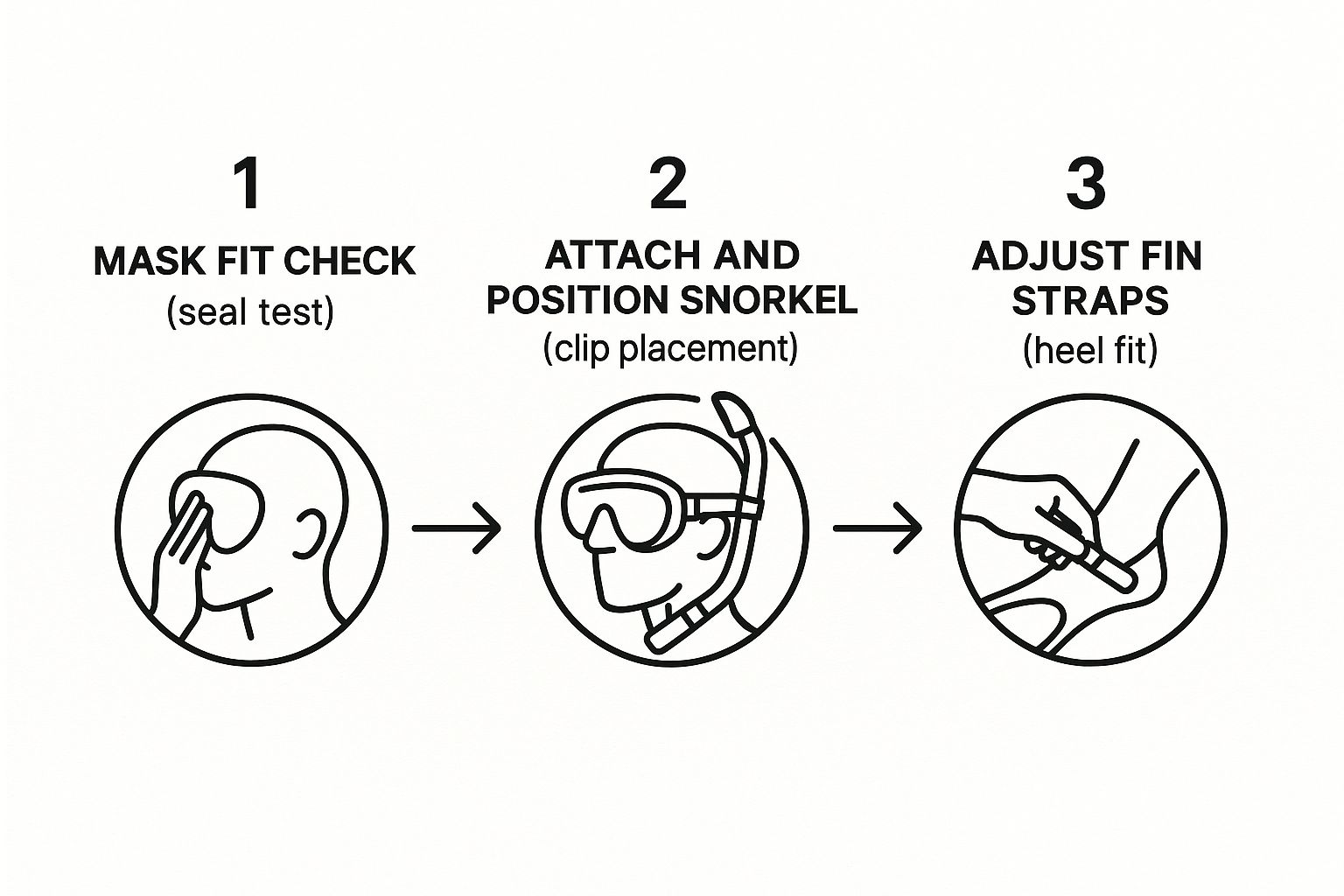
Putting your gear on in the right order—mask check, snorkel placement, then fin adjustment—is the foundation for a great time out on the water.
Choosing Fins for Effortless Movement
Fins might seem like an accessory, but they are essential. They turn clumsy kicking into powerful, efficient propulsion and let you cover way more ground without getting tired.
Your main choice will be between full-foot and open-heel designs. Full-foot fins are worn barefoot and are perfect for the warm waters here in Kona. Open-heel fins require you to wear neoprene booties, which is a good call if you're entering the water over sharp lava rock or if your feet get cold easily.
The stiffness of the fin blade also matters. A more flexible blade is easier on your leg muscles and great for leisurely snorkeling, while a stiffer blade gives you more power for every kick—something more experienced snorkelers or free divers might prefer.
Mastering Your Breathing and Buoyancy
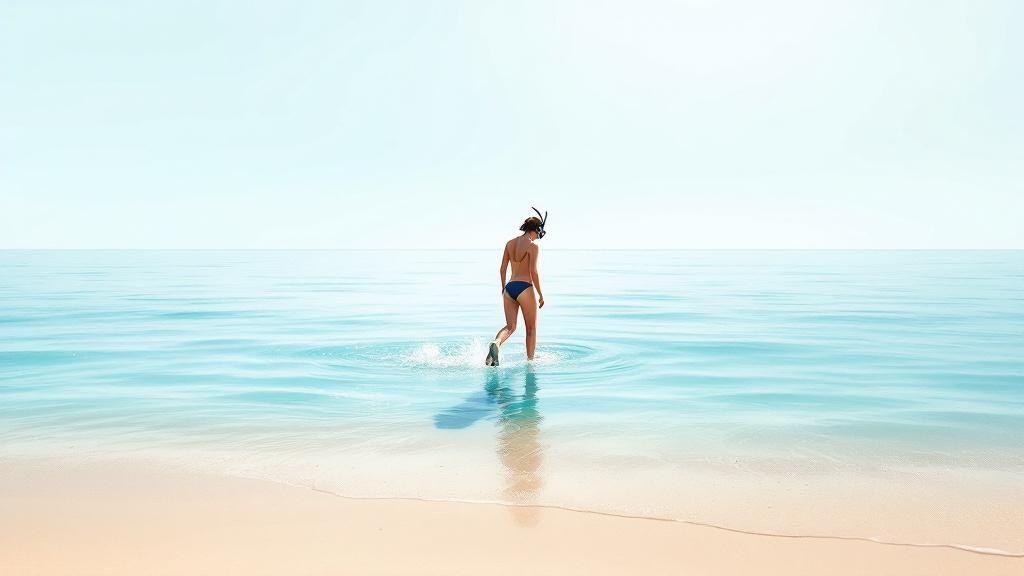
Okay, this is where the magic really happens. Once you’ve got your gear sorted, the next step is to go from being a visitor on the surface to a graceful part of the underwater world. To do that, we need to master the two B's of snorkeling: breathing and buoyancy.
A great snorkeling trip lives and dies by your breathing. The key is to stay calm and rhythmic. It’s going to feel a little weird at first, but your goal is to breathe much more slowly and deeply than you normally would on land. This isn't just about comfort; it's physiology. Slow, deep breaths bring your heart rate down, save your energy, and keep you relaxed. That means more time in the water enjoying the view. Panicked, shallow breathing is the fastest way to feel tired and anxious out there.
Practicing the Basics
Before you even think about heading out to the reef, find a calm, shallow spot where you can easily stand up. Put on your mask and snorkel, and just put your face in the water while standing. Get used to the feeling. Practice breathing slowly and deliberately through the tube until it feels second nature.
For a deeper dive into the mechanics of it all, check out our complete guide on how to breathe when snorkeling for some more advanced tips.
Now, let's talk about clearing your snorkel. Sooner or later, a wave or a splash will get some water in your tube. Don't panic! This is completely normal. What you need is the "blast clear."
It’s simple:
- Take a breath.
- Then, give a single, forceful exhale—think of blowing out a birthday candle from across the room.
- This powerful puff of air will shoot the water right up and out the top of the snorkel.
Do this a few times in the shallows. Once you've got it down, you'll have a ton more confidence in the water.
Achieving the Perfect Float
When you’re comfortable with your breathing, it’s time to work on your body position. The goal is to float effortlessly on the surface, almost like a log. This horizontal position is how you’ll conserve the most energy and get the best view of the reef below without disturbing anything.
Pro Tip: Keep your arms out of it. Most people want to paddle with their hands, but your fins are what give you power. I tell people to tuck their arms at their sides or clasp them behind their back to resist the urge.
Your fin kicks should be slow, small, and come from your hips, not your knees. Imagine your entire leg, from hip to fin-tip, is one long paddle. This gentle flutter kick will move you through the water with surprising ease. By mastering this relaxed float, you become less of an intruder and more of a silent observer in the incredible world unfolding below you.
Essential Ocean Safety and Etiquette
Knowing how to use your gear is only half the battle. To be a truly great snorkeler, you need to understand how to stay safe while respecting the fragile underwater world you’ve come to admire. The ocean is beautiful but powerful, and approaching it with a healthy dose of awareness is non-negotiable.
The biggest rule is also the simplest: never, ever snorkel alone. Always have a buddy or go with a guided group. Even the strongest, most experienced swimmers can run into unexpected trouble. Having someone right there can turn a potential emergency into a minor hiccup. Think of it as the golden rule of water safety.
Reading the Water and Staying Prepared
Before you even think about putting a fin in the water, stop and observe for a minute. What’s the water doing? Look for the direction and strength of the current. Are the waves gentle little lappers, or are they crashing with force? How clear is the water? If visibility is poor, it’s not just less fun—it can get you turned around and disoriented fast.
Even on the calmest days, little things can go wrong. Knowing how to handle them without panicking is what keeps a minor issue from becoming a major problem.
- Flooded Mask: It happens to everyone. Don't freak out. Just lift your head out of the water, pull the bottom of the mask away from your face to let the water drain, and press it back on to get a good seal.
- Leg Cramp: A classic. Straighten your leg and flex your foot hard, pointing your toes back toward your shin. This usually does the trick. Signal your buddy if you need a hand staying afloat while you stretch it out.
- Feeling Tired: If you start to feel winded, just roll onto your back and float. The saltwater will do most of the work for you. This is where a good snorkel vest really provides some extra peace of mind.
Remember: A calm mind is your most valuable piece of safety gear. Panicking just wastes energy and clouds your judgment. Practice these quick fixes in shallow water until they feel like second nature.
Be a Good Guest in the Underwater World
When you enter the ocean, you're a visitor in someone else's home. The vibrant world you're looking at is a delicate ecosystem, and your actions have a direct impact on its health. This is where good snorkeling etiquette is key.
The number one rule is look, but don't touch. Coral is a living animal, not a rock. Even a gentle brush with your finger or fin can damage its protective outer layer, leaving it vulnerable to disease and death. The same goes for all marine life. Admire sea turtles and colorful fish from a respectful distance. Chasing them down causes stress and disrupts their natural behavior. Gentle giants like manta rays are majestic to watch, but you still need to give them their space. Curious about them? You can find out more by reading our article on whether manta rays can sting you.
Also, make sure you're wearing reef-safe sunscreen. The chemicals in standard sunscreens, like oxybenzone and octinoxate, are incredibly toxic to coral reefs. And finally, never, ever feed the fish. It messes up their natural diet and can make them aggressive toward people. By following these simple guidelines, you’re doing your part to protect this incredible environment for generations to come.
Your First Snorkel Adventure in Kona
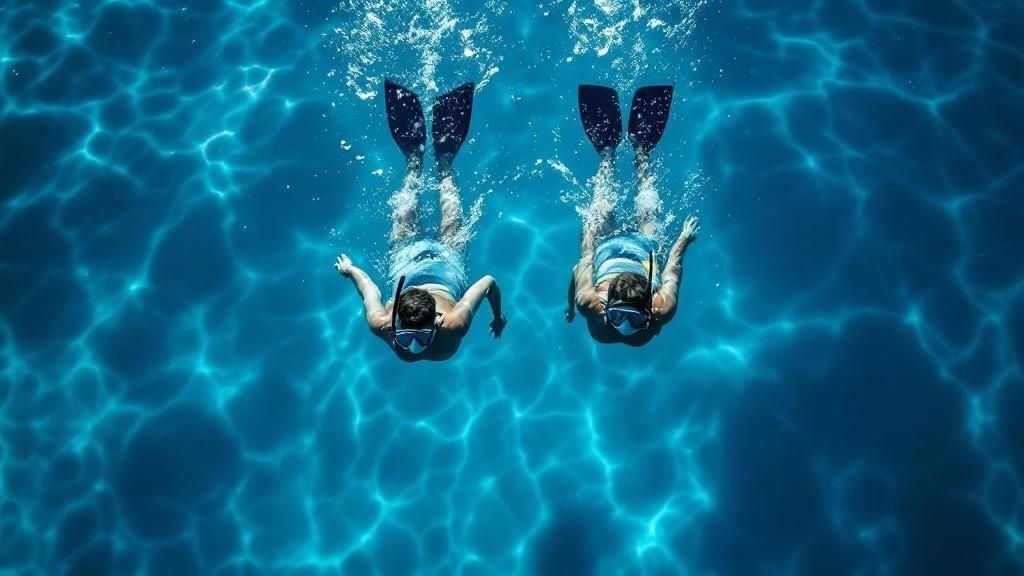
Okay, you've got your gear and you've practiced the basics. Now for the fun part—getting in the water in one of the best snorkeling destinations on the planet. Kona's underwater world is a playground, and this is your guide to making that first dip absolutely unforgettable.
The secret to a fantastic first time is picking the right spot. You're looking for calm, clear, shallow water that's full of life to help you build confidence. For that reason, my go-to recommendation for beginners is always Kahaluʻu Beach Park. It has a natural breakwater that creates a mellow, almost pool-like environment, which is perfect for getting your fins wet.
Your Pre-Snorkel Checklist
A little preparation goes a long way. Before you even leave for the beach, running through a quick mental checklist will save you from common headaches and make sure your time in the water is pure enjoyment.
- Check the Surf Report: Always take a peek at the local conditions. Even a protected spot like Kahaluʻu can get a bit choppy when a big swell rolls in.
- Defog Your Mask: This is a non-negotiable step! Use a commercial anti-fog solution or just a tiny drop of baby shampoo on the inside of the dry lens. Rub it around, then give it a quick dunk in the ocean right before you put it on.
- Gear Check: Make sure your snorkel is clipped securely to your mask strap. Check that your fin straps are snug but not cutting off circulation. You want them tight enough that they won't fall off.
- Time it Right: The morning is almost always the best time to go. The water is usually calmer, the visibility is clearer, and you'll beat the bigger afternoon crowds.
What You Might See in Kona
The moment you slip into the water at Kahaluʻu, you've entered a different universe. This is the real reward for learning to snorkel—witnessing this vibrant world firsthand. Keep your eyes open for some of Kona's most iconic marine residents.
You'll almost certainly be greeted by schools of brilliant yellow tang and the unmistakable Moorish idol. Look for colorful butterflyfish nibbling on the coral and our state fish, the humuhumunukunukuāpuaʻa (reef triggerfish), darting between the rocks. For a truly next-level experience, consider a trip to a place known for its incredible biodiversity, like the world-famous Kealakekua Bay snorkeling.
The most magical encounter, and one that people never forget, is with the Hawaiian green sea turtle, or honu. These gentle giants glide through the water with an ancient grace. Just remember to give them plenty of space and admire them from a respectful distance—never, ever touch them.
Your first snorkel in Kona is more than just an activity; it's a connection to the pulse of the ocean. If this experience leaves you hungry for more, especially in spots with deep historical and ecological significance, you might want to check out our guide on snorkeling the Captain Cook Monument, another of Kona's crown jewels.
A Few Lingering Questions
Even with the best preparation, a few common questions always seem to surface right before someone's first big snorkeling trip. Getting these sorted out beforehand can make all the difference, helping you trade anxiety for pure excitement. Let's tackle some of the ones we hear most often.
Probably the number one concern we hear is about swimming skills. It’s a totally valid question that keeps a lot of would-be adventurers on the shore, but the answer might surprise you.
Can I Snorkel if I Can't Swim Well?
Absolutely. While being a strong swimmer is a great skill to have for any water activity, it's not a deal-breaker for snorkeling. The secret weapon here is a flotation device. A good snorkel vest or even a humble pool noodle provides all the buoyancy you need, letting you float effortlessly on the surface without having to tread water.
This support frees you up to focus on what matters: your breathing and the incredible world unfolding below. You're not focused on staying afloat; the gear handles that. Just make sure to start in calm, shallow water with a guide or a buddy, and you'll quickly realize snorkeling is much more about floating than it is about hardcore swimming.
Your gear is designed to do the heavy lifting for you. The flotation aid keeps you buoyant, the fins provide easy propulsion, and the mask and snorkel let you breathe and see. Trust your equipment, and you’ll feel surprisingly secure.
How Do I Keep My Mask from Fogging Up?
There’s nothing worse than a mask that fogs up the second you hit the water, blurring your view of a passing turtle. This happens because of condensation, but thankfully, it’s an easy fix.
The most reliable trick in the book is to use a pea-sized amount of commercial anti-fog solution. In a pinch, a little baby shampoo works wonders, too. Just put a small dab on the inside of your dry lens and rub it all over the glass with your finger. Give it a quick, gentle rinse in the ocean right before you put it on. This leaves a thin, invisible film that stops the fog from ever forming. Pro tip: once you've treated it, don't touch the inside of the lens again!
Can I Wear My Glasses Under My Snorkel Mask?
This is a definite no-go. The arms of your glasses will break the silicone seal of the mask against your face, guaranteeing a constant, annoying leak. But don’t worry, you've got much better options.
- Contact Lenses: If you're a contact lens wearer, you're in luck. They work perfectly with any standard snorkel mask and are the easiest solution.
- Decent Natural Vision: Many people with minor prescriptions find they don't even need correction. The water itself provides a slight magnification, which is often just enough to see everything clearly.
- Prescription Masks: If you have a stronger prescription, a prescription snorkel mask is a game-changer. You can get these with lenses made to your exact prescription, giving you a crystal-clear, high-definition view of the reef.
Getting these common worries out of the way can clear the path for an amazing time. For more specific local tips, you should check out these frequently asked questions about Kona snorkel tours. It'll help you feel even more prepared for your Big Island adventure.
Ready to experience the vibrant underwater world of Hawaii for yourself? Kona Snorkel Trips offers the highest-rated snorkel adventures on the Big Island. Join our expert guides for a safe, unforgettable journey. Book your tour today!
